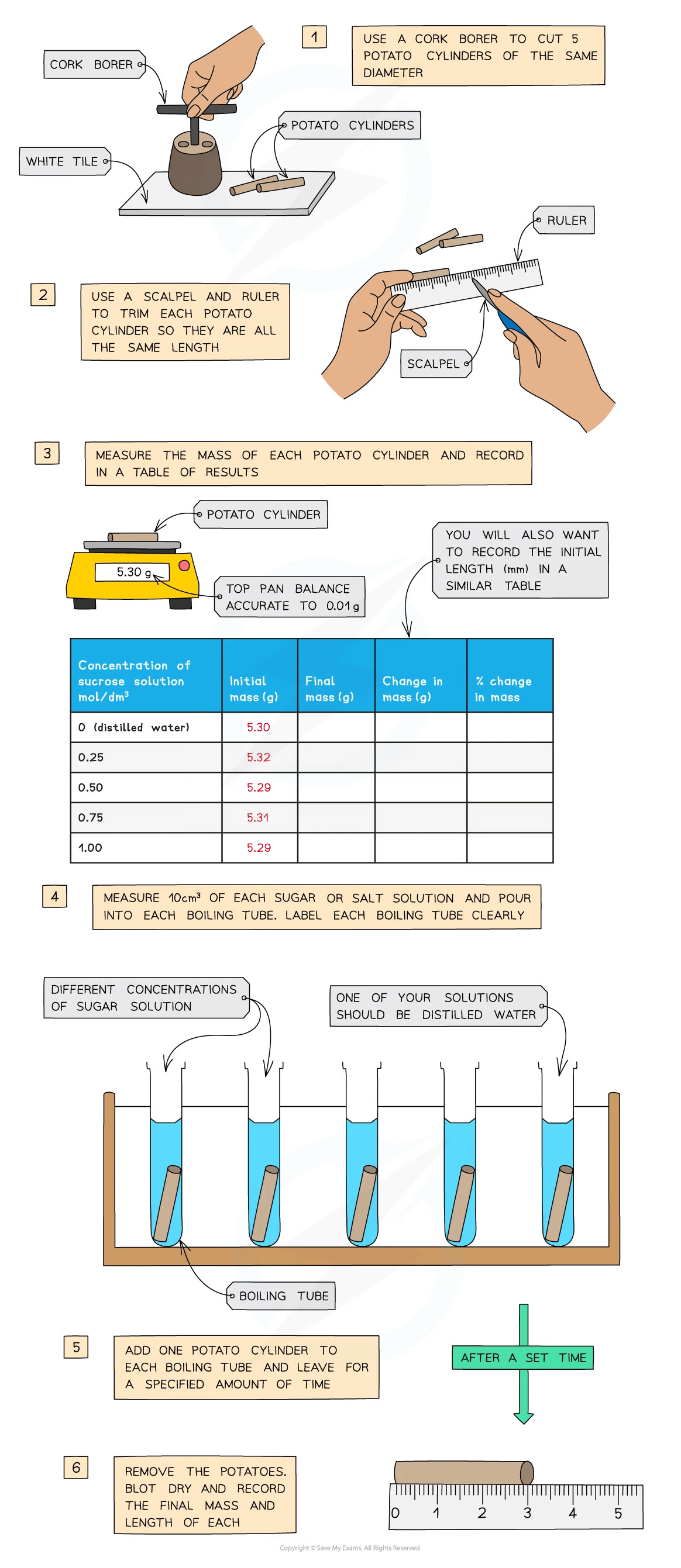Estimating Water Potential in Plants (Cambridge (CIE) AS Biology): Revision Note
Exam code: 9700
Estimating water potential in plant tissue
It is possible to investigate the effects of immersing plant tissue in solutions of different water potentials and then use the results to estimate the water potential of the plant tissue itself
The most common osmosis practical of this kind involves cutting cylinders of potato and placing them into solutions with a range of different water potentials
These are usually sucrose solutions of increasing concentration
At least five different concentrations are usually required
Method
The required number of potato cylinders are cut (one for each of the solutions you are testing—or more than one per solution if you require repeats; this is good experimental practice)
They are all cut to the same length and, once blotted dry to remove any excess moisture, their initial mass is measured and recorded before placing into the solutions
They are left in the solutions for a set length of time (e.g., 30 minutes), usually in a water bath (set at around 30o)
They are then removed and dried to remove excess liquid
The final length and mass of each potato cylinder are then measured and recorded

Analysis
The percentage change in mass for each potato cylinder is calculated
If there is a potato cylinder that has neither increased nor decreased in mass, it means there was no overall net movement of water into or out of the potato cells
This is because the solution that this particular potato cylinder was in had the same water potential as the solution found in the cytoplasm of the potato cells
So there was no concentration gradient and therefore no net movement of water into or out of the potato cells
The concentration of sucrose inside the potato cylinders can be found if a graph is plotted showing how the percentage change in mass changes with the concentration of sucrose solution
The point at which the line of best fit crosses the x-axis is the concentration of sucrose inside the potato cylinders

A positive percentage change in mass indicates that the potato has gained water by osmosis (net movement of water from the solution into the potato) meaning the solution had a higher water potential than the potato
This would make the potato cells turgid, as the water exerts turgor pressure (or hydrostatic pressure) on the cell walls—the potatoes will feel firm
A negative percentage change suggests the opposite, that is, the solution had a lower water potential than the potato
The potato cylinder in the strongest sucrose concentration will have decreased in mass the most as there is the greatest concentration gradient in this tube between the potato cells (higher water potential) and the sucrose solution (lower water potential)
This means more water molecules will move out of the potato cells by osmosis, making them flaccid and decreasing the mass of the potato cylinder – the potato cylinders will feel floppy
If looked at underneath the microscope, cells from this potato cylinder might be plasmolysed, meaning the cell membrane has pulled away from the cell wall
Examiner Tips and Tricks
Questions involving osmosis experiments are common and you should be able to use your knowledge of osmosis to explain the results obtained.
If describing or analysing an experiment remember to include mention of variables that need to be controlled and mention repeats, as this helps improve the reliability of the results obtained.
Don’t worry if it is an experiment you haven’t done yourself in the lab – simply figure out where the higher concentration of water molecules is (the solution with the higher water potential) and explain which way the molecules move due to the differences in water potential.

Unlock more, it's free!
Did this page help you?